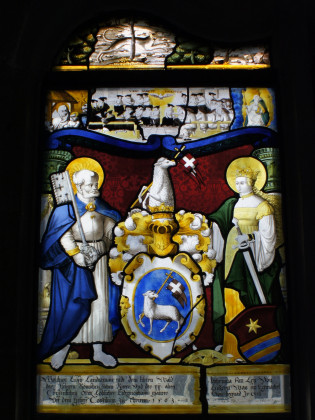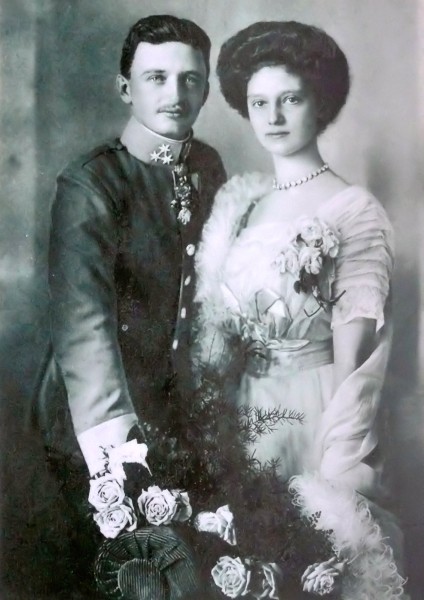The cloister with the Renaissance stained glass windows
The original cloister was built in 1534/35 under Abbot Laurenz von Heidegg. Unfortunately, the Gothic gallery was partially destroyed during the reconstruction of the church in 1695.
The inner courtyard and the three remaining cloister wings were restored in proper style between 1953 and 1957 by the Murian stone sculptor Romano Galizia. At the same time, the unique Renaissance stained glass windows (which had been kept in Aarau since the dissolution of the monastery) could be reinstalled.
Left: King Louis XIII of France (1625) Coat of arms of the King of France and Navarre; allegories of war and peace; the shield holders are Charlemagne and Saint Louis IX
Middle: Emperor Ferdinand I. (1563) Coat of arms of the Emperor, surrounded by columns with satyrs
Right: King Philip II of Spain (1580) Coat of arms of the Kingdom of Spain, in the base two small coats of arms of the envoy Pompeio della Croce; in the upper pictures the Solomonic judgement as well as homage by presentation of flowers and honey.

Click on the windows to enlarge!
Left: Einsiedeln Monastery (1557) coat of arms with four parts: in fields 1 and 4 are coats of arms of the monastery, in fields 2 and 3 coats of arms of Abbot Joachim Eichhorn. To the right of the shield is Maria, to the left Meinrad of Einsiedeln; in the upper picture Annunciation to Maria.
Middle: Christoph Metzler, Bishop of Constance (1557) Fourth coat of arms; in fields 1 and 4 the coat of arms of the diocese, in fields 2 and 3 the Metzler of Feldkirch; next to the shield the saints Konrad and Pelagius; in the upper picture the crescent moon Madonna in a wreath of clouds.
Right: St. Gallen Monastery (1557) Coat of arms of the Abbey, the County of Toggenburg and the Blarer von Wartensee; next to the shields the saints Gallus and Otmar von St. Gallen; in the upper picture Gallus in prayer and with the bear.

Click on the windows to enlarge!

Also Melchior Lussy, Landammann Nidwaldens, donated a window in the 16th century. I have already met his coat of arms on the Way of St James in Stans. He was also a pilgrim and went on pilgrimage to Jerusalem and to Santiago de Compostella.
He is depicted here as Peter and carries a special key, namely the one from the Nidwalden coat of arms.
On the right of the picture is Catherine Amlehn of Lucerne, his first wife, depicted as St. Catherine.
1562-63 Lussy was envoy of the catholic places at the Council of Trent. Therefore the upper picture shows the Council. The Holy Spirit floats as a dove in the middle, above it
the words "veni sancte spiritus".

Click on the windows to enlarge!
Heart tomb of the Habsburgs and tombs of the Habsburg ancestors

Picture of Emperor Charles (Karl) I and Empress Zita
The last resting place of emperor Karl is on the island Madeira.
In the north wing of the cloister is the Loreto Chapel. This chapel from 1698 is a replica of the "Casa Santa" of Loreto near Ancona, Italy.
The hearts of the last Austrian imperial couple, Charles I and Zita of Bourbon-Parma are buried in this chapel. The heart of their son Otto von Habsburg was buried in the
Hungarian monastery of Pannonhalma.
From the cloister one enters a treasure chamber. Here are the remains of a collection of cult devices and paraments from the 16th to 18th century.
During the time of the French occupation in 1798 and when the canton abolished the monastery in 1841, the greater part of the monastery treasure was scattered to the four winds.
I was particularly struck by the silver tabernacle and the clock.
The silver tabernacle (1700/1704) was made by the Swiss artists Hans Peter Staffelbach and Hans Georg Ott.
The relief on the base shows the Lord's Supper. The upper scene on the door depicts the crucifixion, the lower one the dice around Jesus' robe.
On the columns to the left and right are angels, a lace lead of baroque goldsmith's art.
This clock was a gift from Emperor Karl I, who lived for some time in 1921 at Hertenstein Castle near Weggis. The presentee, the detective sergeant Fritz Huwiler of the Lucerne cantonal police had only trouble with the watch and left the police service.

Only one plaque remains of the Franz Morawetz watchmaker's shop in Vienna at Kohlmarkt 11. The shop was replaced by a boutique.
Since the redesign of the museum in 2014
you can see this clock at the entrance to the museum.